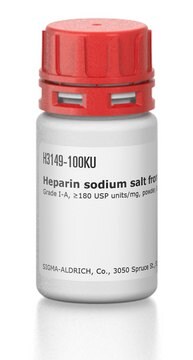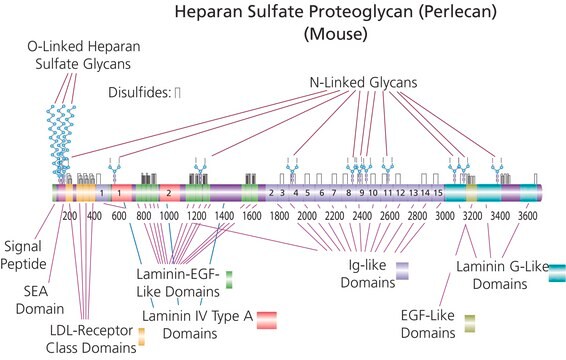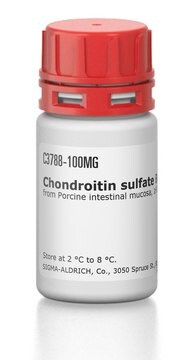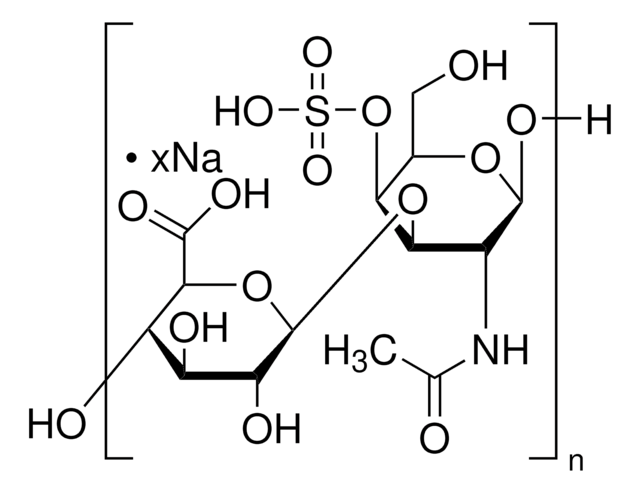추천 제품
제품명
Heparan sulfate sodium salt from bovine kidney,
저장 온도
2-8°C
유사한 제품을 찾으십니까? 방문 제품 비교 안내
애플리케이션
Heparan sulfate sodium salt from bovine kidney has been used:
- to investigate its effect on proliferation of B cells
- to monitor its role on eye development in E5 embryonic cells
- to study its binding with exosome fibronectin in human trabecular meshwork cells using dot blot
생화학적/생리학적 작용
Constituent of membrane-associated proteoglycans suggested to contribute to cell-cell adhesion
Heparan sulphate (HS), a ubiquitous glycosaminoglycan, is a polymer of D-glucuronic acid or L-iduronic acid and D-glucosamine (GlcA) sugars. It is synthesized in the cis-Golgi as heparan. In Golgi, final heparan sulphate is synthesized in by the action of enzymes N- and O-HS-sulphotransferases and HS epimerase. The mature HS has 50 to 200 disaccharide units. It is part of the extracellular matrix (ECM) and plays a key role in the oncogenic pathway. Deregulation of heparin sulfate metabolism is implicated in cancer progression. HS is associated with the onset of infectious diseases and inflammatory conditions. HS interaction with Aβ fibrils contributes to the pathophysiology of Alzheimer′s disease.Heparan sulphate is a constituent of membrane-associated proteoglycans suggested to contribute to cell-cell adhesion.
Storage Class Code
11 - Combustible Solids
WGK
WGK 3
Flash Point (°F)
Not applicable
Flash Point (°C)
Not applicable
개인 보호 장비
Eyeshields, Gloves, type N95 (US)
Y Tanaka et al.
The Journal of experimental medicine, 184(5), 1987-1997 (1996-11-01)
Leukocyte migration from circulation into tissue depends on leukocyte integrin-mediated adhesion to endothelium, but integrins cannot function until activated. However, it remains to be understood how tumor cells adhere to endothelium and infiltrate into underlying tissue. We studied mechanisms of
K Fuxe et al.
Brain research, 746(1-2), 25-33 (1997-01-23)
In the present paper immunocytochemical analysis at the fluorescence microscopical level has been performed of neural cell adhesion. molecule (NCAM) immunoreactivity in the adult rat tel- and diencephalon in order to further substantiate the highly selective neuronal localization of NCAM
Molecular diversity of heparan sulfate
Esko JD and Lindahl Ulf
The Journal of Clinical Investigation, 108(2), 169-173 (2001)
Mechanism of fibronectin binding to human trabecular meshwork exosomes and its modulation by dexamethasone
Dismuke WM, et al.
Testing, 11(10), e0165326-e0165326 (2016)
Towards understanding the roles of heparan sulfate proteoglycans in Alzheimer?s disease
Zhang GL, et al.
BioMed Research International, 2014(6), 555-571 (2014)
문서
There are five identified glycosaminoglycan chains (see Figure 1): Hyaluronan is not sulfated, but the other glycosaminoglycan chains contain sulfate substituents at various positions of the chain.
Glycosaminoglycans are large linear polysaccharides constructed of repeating disaccharide units.
자사의 과학자팀은 생명 과학, 재료 과학, 화학 합성, 크로마토그래피, 분석 및 기타 많은 영역을 포함한 모든 과학 분야에 경험이 있습니다..
고객지원팀으로 연락바랍니다.







